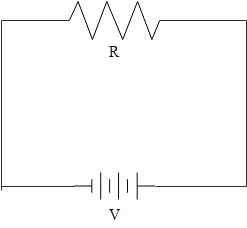
Answer
379.1k+ views
Hint: The work done of a battery is found by taking the product of charge of the battery and the electric potential of the battery. Substitute the values given in the question and find out the value of work done. This will be helpful in solving this question.
Complete step by step answer:
First of all let us mention what all are given in the question. The voltage of the battery has been mentioned as,
$V=10V$
The charge inside the battery is given as,
$q=10000C$
Resistance connected to the battery is given as,
$R=20\Omega $
The time taken for the flow of this much charge through the resistor is mentioned as,
$t=10s$
The work done by the battery can be found by the equation given as,
$w=qV$
Substituting the values in it will be given as,
$w=10\times 20000=2\times {{10}^{5}}J$

So, the correct answer is “Option B”.
Note: A battery is defined as a device which can be used to store chemical energy and then convert it into electrical energy. The chemical reactions in the battery consist of the flow of electrons from one material known as electrode to another electrode, through an external circuit. The flow of electrons is providing an electric current that can be helpful to do work. If a battery is supplying the electric power. In the battery, the positive terminal is named as the cathode and its negative terminal is named as the anode. Batteries are supplying only the DC voltage. The battery casing is a steel container which holds the electrodes, the anode and the cathode. The cathode is a silvery matte ring which is made of manganese dioxide, graphite and electrolyte. The separator keeps the electrodes at a distance to oppose a short circuit.
Complete step by step answer:
First of all let us mention what all are given in the question. The voltage of the battery has been mentioned as,
$V=10V$
The charge inside the battery is given as,
$q=10000C$
Resistance connected to the battery is given as,
$R=20\Omega $
The time taken for the flow of this much charge through the resistor is mentioned as,
$t=10s$
The work done by the battery can be found by the equation given as,
$w=qV$
Substituting the values in it will be given as,
$w=10\times 20000=2\times {{10}^{5}}J$

So, the correct answer is “Option B”.
Note: A battery is defined as a device which can be used to store chemical energy and then convert it into electrical energy. The chemical reactions in the battery consist of the flow of electrons from one material known as electrode to another electrode, through an external circuit. The flow of electrons is providing an electric current that can be helpful to do work. If a battery is supplying the electric power. In the battery, the positive terminal is named as the cathode and its negative terminal is named as the anode. Batteries are supplying only the DC voltage. The battery casing is a steel container which holds the electrodes, the anode and the cathode. The cathode is a silvery matte ring which is made of manganese dioxide, graphite and electrolyte. The separator keeps the electrodes at a distance to oppose a short circuit.
Recently Updated Pages
How many sigma and pi bonds are present in HCequiv class 11 chemistry CBSE

Mark and label the given geoinformation on the outline class 11 social science CBSE

When people say No pun intended what does that mea class 8 english CBSE

Name the states which share their boundary with Indias class 9 social science CBSE

Give an account of the Northern Plains of India class 9 social science CBSE

Change the following sentences into negative and interrogative class 10 english CBSE

Trending doubts
Difference between Prokaryotic cell and Eukaryotic class 11 biology CBSE

Which are the Top 10 Largest Countries of the World?

Differentiate between homogeneous and heterogeneous class 12 chemistry CBSE

Fill the blanks with the suitable prepositions 1 The class 9 english CBSE

Difference Between Plant Cell and Animal Cell

Give 10 examples for herbs , shrubs , climbers , creepers

The Equation xxx + 2 is Satisfied when x is Equal to Class 10 Maths

Write a letter to the principal requesting him to grant class 10 english CBSE

Change the following sentences into negative and interrogative class 10 english CBSE



